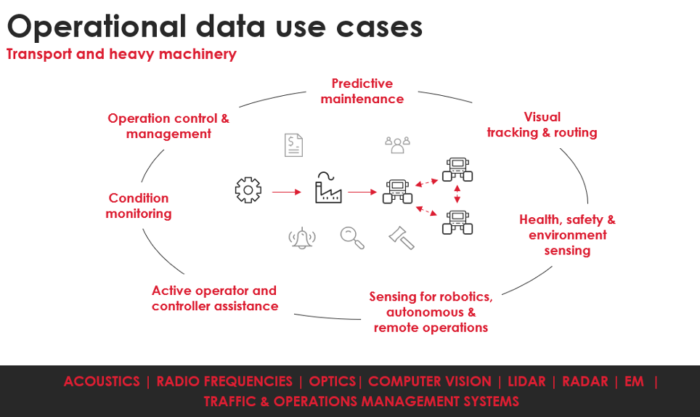Organisations are increasingly making use of operational analytics in their critical business processes to support digital transformation activities and to improve and optimise the performance of their assets.
Whether it is about manufacturing, transport and heavy machinery industry – just to name a few – real-time analytics aims at improving overall equipment effectiveness (OEE) which has usually been considered one of the most essential indicators of industrial excellence.
In the manufacturing and production industries, OEE is typically measured by availability, performance and quality while in the transport or rolling stock industries OEE can be defined by punctuality, fluency and capacity.
In this post, the term “business real-time operational analytics” is considered as a low-latency analytical information processing where business-relevant decisions or actions as outcomes are conducted on time scale from seconds to minutes after observed information inputs. This is an important differentiation to true safety and mission-critical real-time control systems with hard requirements for predictable and specific time requirements for information processing and quality of delivery.
When being dependent (i.e. mission-critical) on real-time analytics, serious and surprising challenges may result if the input data and analytic algorithms are flawed or intersystem connectivity is interrupted. Additionally, companies cannot improve or operate efficiently if they cannot measure or collect data. Thus data must be accessible and effort should be put into defining things to be measured and observed.
Generally speaking, business real-time data can be used for operational intelligence purposes for sharing a broader situational awareness for a larger organisation. Ability to visually and logically represent the state and analytical insight of a real-world system and its operational data helps organisations to conduct better decisions based on shared truth. Therefore, spatial or logical digital twins and supervisory control centers solutions as a way to convey the relevant information to correct users or functions are becoming natural components of operational intelligence capabilities.
Whether real-time analytics are available or not, decisions are typically real-time. Real-time data and analytics are not even always appropriate, and hence real-time analytics should be used only when it is considered essential. But when the real-timeness matters, only crucial data should be summarized and important issues highlighted to avoid information overflow. Too much information is as problematic as too little information when making time-critical decisions.
Real-time analytics enables users to react without delay, quickly detect and identify rising problems or exploit opportunities that could otherwise be missed. Hence real-time analytics makes possible to reduce business and operational risks through the predictiveness that real-time analytics foster.
Taking analytics to the next level with AI and Edge computing
At its best when combined with AI tools, machine learning, reporting, data stream processing and optimization tools, real-time analytics can even suggest alternatives and potential countermeasures rather than relying on the old habits and procedures. Increasing computing capacity and shorter communicational delays are opening a range of new opportunities. For instance common operational situational awareness can be further enhanced with multi-source real-time data streams like from computer vision sensors.
Even though cloud technology has enabled a massive leap in computing and even yet all of its benefits and capabilities have not been fully embraced, large data volumes and streams set requirements for data processing close to its sources. Hence decentralised software architecture and edge computing solutions are critical elements in designing real-time systems.
Edge and cloud computing embodies a paradigm change that decentralizes the communication, computation, control and storage resources. There are still severely connectivity-constrained places, locations and environments on this planet. Edge computing is a key technology that enable time-sensitive operational analytics in applications where connectivity constraints shall not compromise the desired functionality.
Since transportation or other systems with moving objects produce a massive amount of data in real-time, especially edge computing is believed to bring novel opportunities to analyse and aggregate massive data sets from any vehicle or a fleet of vehicles as soon as the data is collected. Hence the meaningful and mission-critical data can be passed on to the relevant parties.
Despite the benefits of edge and cloud computing, one of the greatest challenges is defining a flexible and reusable architecture that is feasible for digesting and processing data instantly and it has to be capable of handling quick changes in data volume and should be able to scale up as the data grows.
Managing the scale and complexity of decentralised edge-enabled analytics requires new approaches for continuous development and operations through the solution lifecycle. Therefore also the purpose of cloud hyperscalers is changing – from pure centralised computational platforms towards control places of distributed cloud-to-edge continuums.
Advantages of real-time analytics
Back in the days, analytics solutions were unable to display analysed results quickly enough but especially rise of state-of-the-art edge and cloud computing is making a huge change and will open completely new application areas and use cases with multiple benefits:
Improved fact-based decision-making at the right time: With real-time analytics you can keep up with the fast-paced modern business.
Keeping business constantly on the right track: up-to-date data helps organisations to see the trajectory of business and enables them when and how to act.
Instant detection and monitoring of mission-critical issues: Highly valued by the users as they can spot problems before they spiral out of control and address them according to guidelines.
Connected user experience and engagement: Providing improved customer engagement, acceptance and satisfaction through more personalized customer strategies.
ompetitive advantage: Being capable of staying one step ahead by identifying market fluctuations and trends.
Improved efficiency and safety: real-time sensing enables situational awareness that can be used to assist drivers and fleet supervisors to perform better, safer and more efficiently.


